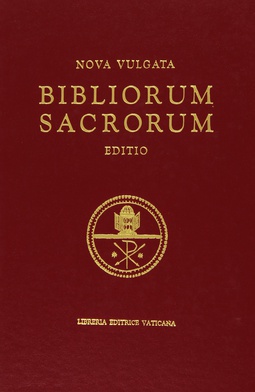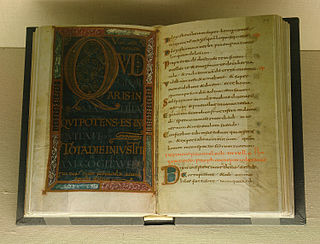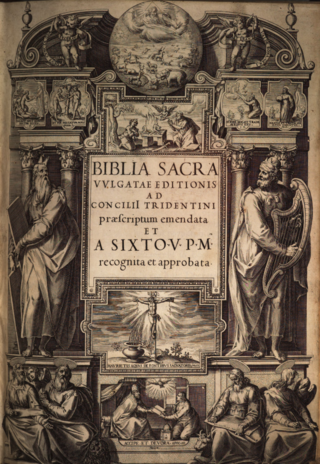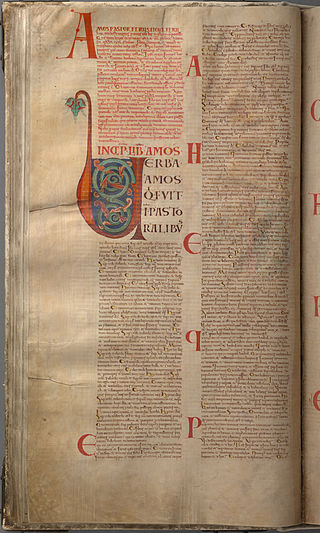Related Research Articles

The Old Testament is the first division of the Christian biblical canon, which is based primarily upon the 24 books of the Hebrew Bible or Tanakh, a collection of ancient religious Hebrew writings by the Israelites. The second division of Christian Bibles is the New Testament, written in the Koine Greek language.

The Septuagint, is the earliest extant Greek translation of the Hebrew Bible from the original Hebrew. The full title derives from the story recorded in the Letter of Aristeas to Philocrates that "the laws of the Jews" were translated into the Greek language at the request of Ptolemy II Philadelphus by seventy-two Jewish translators—six from each of the Twelve Tribes of Israel.

The Vulgate is a late-4th-century Latin translation of the Bible.

The Codex Vaticanus, designated by siglum B or 03, δ 1, is a fourth-century Christian manuscript of a Greek Bible, containing the majority of the Greek Old Testament and the majority of the Greek New Testament. It is one of the four great uncial codices. Along with Codex Alexandrinus and Codex Sinaiticus, it is one of the earliest and most complete manuscripts of the Bible. The codex has been dated palaeographically to the 4th century.

The Bible has been translated into many languages from the biblical languages of Hebrew, Aramaic, and Greek. As of 2022 all of the Bible has been translated into 724 languages, the New Testament has been translated into an additional 1,617 languages, and smaller portions of the Bible have been translated into 1,248 other languages according to Wycliffe Global Alliance. Thus, at least some portions of the Bible have been translated into 3,589 languages.

1 Esdras, also Esdras A, Greek Esdras, Greek Ezra, or 3 Esdras, is the ancient Greek Septuagint version of the biblical Book of Ezra in use within the early church, and among many modern Christians with varying degrees of canonicity. 1 Esdras is substantially similar to the standard Hebrew version of Ezra–Nehemiah, with the passages specific to the career of Nehemiah removed or re-attributed to Ezra, and some additional material.

The Nova Vulgata, also called the Neo-Vulgate, is the official Classical Latin translation of the original-language texts of the Bible published by the Holy See. It was completed in 1979, and was promulgated the same year by John Paul II in Scripturarum thesaurus. A second, revised edition was published in 1986. It is the official Latin text of the Bible of the Catholic Church. The Nova Vulgata is also called the New Latin Vulgate or the New Vulgate.
Mount Amana is an ancient name for the southern Anti-Lebanon Mountains.

Edward Robinson was an American biblical scholar known for his magnum opus, Biblical Researches in Palestine, the first major work in Biblical Geography and Biblical Archaeology, which earned him the epithets "Father of Biblical Geography" and "Founder of Modern Palestinology."

Gopher wood or gopherwood is a term used once in the Bible for the substance from which Noah's ark was built. Genesis 6:14 states that Noah was to build the Ark of gofer, more commonly transliterated as gopher wood, a word not otherwise known in the Bible or in Hebrew. Although some English Bibles attempt a translation, older English translations, including the King James Version, leave it untranslated. The word is unrelated to the name of the North American animal known as the gopher.

The additions to Daniel comprise three chapters not found in the Hebrew/Aramaic text of Daniel. The text of these chapters is found in the Koine Greek Septuagint, the earliest Old Greek translation.

The biblical apocrypha denotes the collection of apocryphal ancient books thought to have been written some time between 200 BC and AD 400. The Roman Catholic, Eastern Orthodox and Oriental Orthodox churches include some or all of the same texts within the body of their version of the Old Testament, terming them deuterocanonical books. Traditional 80-book Protestant Bibles include fourteen books in an intertestamental section between the Old Testament and New Testament called the Apocrypha, deeming these useful for instruction, but non-canonical. To this date, the Apocrypha are "included in the lectionaries of Anglican and Lutheran Churches". Anabaptists use the Luther Bible, which contains the Apocrypha as intertestamental books; Amish wedding ceremonies include "the retelling of the marriage of Tobias and Sarah in the Apocrypha". Moreover, the Revised Common Lectionary, in use by most mainline Protestants including Methodists and Moravians, lists readings from the Apocrypha in the liturgical calendar, although alternate Old Testament scripture lessons are provided.

The Latin Psalters are the translations of the Book of Psalms into the Latin language. They are the premier liturgical resource used in the Liturgy of the Hours of the Latin Rites of the Roman Catholic Church.
Franz Philip Kaulen was a German Catholic scriptural scholar.

The Tetragrammaton, or Tetragram, is the four-letter Hebrew theonym יהוה, the name of God in the Hebrew Bible. The four letters, written and read from right to left, are yodh, he, waw, and he. The name may be derived from a verb that means "to be", "to exist", "to cause to become", or "to come to pass". While there is no consensus about the structure and etymology of the name, the form Yahweh is now accepted almost universally, though the vocalization Jehovah continues to have wide usage.

Psalm 147 is the 147th psalm of the Book of Psalms, beginning in English in the King James Version, "Praise ye the LORD: for it is good to sing praises". In the slightly different numbering system used in the Greek Septuagint version of the Bible, and in the Latin Vulgate/Vulgata Clementina, this psalm is divided into Psalm 146 and Psalm 147. In Latin, Psalm 146 is known as "Laudate Dominum quoniam bonum psalmus", and Psalm 147 as "Lauda Jerusalem Dominum".

The Sixtine Vulgate or Sistine Vulgate is the edition of the Vulgate—a 4th-century Latin translation of the Bible that was written largely by Jerome—which was published in 1590, prepared by a commission on the orders of Pope Sixtus V and edited by himself. It was the first edition of the Vulgate authorised by a pope. Its official recognition was short-lived; the edition was replaced in 1592 by the Sixto-Clementine Vulgate.

The Sixto-Clementine Vulgate or Clementine Vulgate is the edition promulgated in 1592 by Pope Clement VIII of the Vulgate—a 4th-century Latin translation of the Bible that was written largely by Jerome. It was the second edition of the Vulgate to be authorised by the Catholic Church, the first being the Sixtine Vulgate. The Sixto-Clementine Vulgate was used officially in the Catholic Church until 1979, when the Nova Vulgata was promulgated by Pope John Paul II.

The Bible translations into Latin date back to classical antiquity.

Amos 5 is the fifth chapter of the Book of Amos in the Hebrew Bible or the Old Testament of the Christian Bible. This book contains the prophecies attributed to the prophet Amos, including a lamentation for Israel, Amos 5:1–3; an exhortation to repentance, Amos 5:4–20; and God's rejection of their hypocritical service, Amos 5:21–27. It is a part of the Book of the Twelve Minor Prophets.
References
Footnotes
- ↑ Westcott 1863, p. 1688.
- ↑ Knight 1856, pp. 205–206.
- ↑ Shore 1862, p. 13.
- ↑ Westcott 1863, p. 1690.
- ↑ Westcott 1863, pp. 1689–1690.
- ↑ Calmet 1852, p. 914.
Sources
- Westcott, Brook Foss (1863). "Vulgate, The". In Smith, William (ed.). A Dictionary of the Bible: Red-Sea-Zuzims. Vol. 3. London: John Murray.
- Calmet, Augustin (1852). "Versions". In Taylor, Charles; Robinson, Edward (eds.). Calmet's Dictionary of the Holy Bible (9th ed.). Boston: Crocker and Brewster.
- Knight, Charles, ed. (1856). "Griesbach, John James". The English Cyclopædia: A New Dictionary of Universal Knowledge. Vol. 3. London: Bradbury and Evans.
- Shore, Thomas (1862). The Churchman and the Free Thinker; Or a Friendly Address to the Orthodox. London: Williams and Norgate.